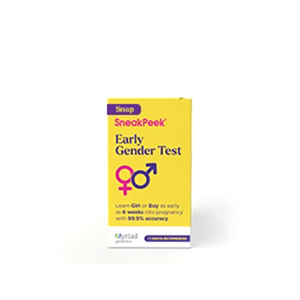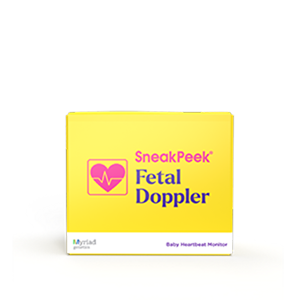Published on September 5th, 2022 and Updated on February 29th, 2024
Check out SneakPeek Gender Test to find out your baby’s gender as early as 6 weeks at over 99% accuracy1!
If you’ve been wondering “am I ready for a baby” or have been trying for a baby for months with no success, one area to explore may be your hormone level—especially progesterone.
Progesterone is necessary for healthy menstruation and reproduction, whether you’re looking for ways to get pregnant fast or not. A low level can create infertility issues, alongside other irritating symptoms (hello, headaches and hot flashes!).
If you’re on a pregnancy plan, you’ll need progesterone on your side. So, let’s dive into low progesterone symptoms, causes, and treatments that moms-to-be may want to know.
What is Progesterone?
Progesterone is a female sex hormone that prepares your body for pregnancy (and maintains a pregnancy) by thickening the uterine lining. A thick uterine lining provides a soft and attachable landing for a fertilized egg to implant in and eventually grow into a baby.
In addition to thickening the uterine lining, progesterone also has these important functions:
- Supporting other sex hormones, like estrogen and testosterone
- Regulating blood pressure
- Improving mood and sleep
- Developing mammary glands for breastfeeding when pregnant
When not pregnant, the levels of progesterone produced by your body rises and falls across your menstrual cycle, following this cyclical pattern:
- Follicular phase – The follicular phase extends from the end of your period up to ovulation. During this time, progesterone stays low, at around 0.89 ng/ml in the bloodstream.
- Ovulation – During ovulation, one of your ovaries releases an unfertilized egg into the Fallopian tubes. This activates the corpus luteum in your ovaries, a hormonal body that supports signs of high fertility in a woman and sex hormone production. The corpus luteum then calls for more progesterone, raising levels up to 1.2 ng/ml.
- Luteal phase – After ovulation, the luteal phase kicks in until your period begins. At this point, the corpus luteum really boosts your progesterone levels, which reach between 1.8 to 24 ng/ml. These higher levels thicken your uterine lining for possible egg implantation. Fun fact: levels of estrogen also spike at this time. Alongside progesterone, these spikes can create other side effects, such as acne and mood swings—what we refer to as PMS symptoms).
- Menstruation – When no egg implants, your corpus luteum shuts down progesterone production. This sudden drop in progesterone (back down to follicular phase levels) triggers menstruation.
What happens to progesterone levels if a fertilized egg does implant?
Basically, that egg tells your corpus luteum to maintain a thickened uterine lining for pregnancy. This keeps your progesterone levels at luteal phase levels or higher—anywhere from 11 to 44 ng/ml.
Low Progesterone Symptoms
Headaches, depression, sore breasts—sound familiar? A low progesterone level may feel a lot like that “special” time of the month. However, there are a few key differences between low progesterone and PMS. If you’re having infertility issues, look for these low progesterone symptoms outside of your premenstrual week:
- Headaches or migraines
- Anxiety
- Depression
- Insomnia or sleeping troubles
- Irregular menstrual cycles or spotting
- Gallbladder problems
A low progesterone level can also mess with your estrogen level, creating even more uncomfortable symptoms. When progesterone goes low, it can lead to unopposed estrogen, or estrogen dominance, triggering symptoms like:
- Weight gain
- Low libido or sex drive
- Sore breasts
- Cystic fibroids
- Light or heavy menstrual bleeding
- Bloating
Causes of Low Progesterone
Your sex hormones are part of an intricate and delicate system. Everything from stress to diet can snowball into a hormonal imbalance. If you believe that your progesterone levels might be low, consider these top causes.
#1 Menopause
Menopause occurs when your body stops ovulating, ceasing all menstruation. This biological shift typically happens around 50 years old but can occur as early as your 40s. As a result of ceased ovulation, menopause also means your sex hormone production drops, including your progesterone production.
If you’re entering your 40s and experiencing low progesterone symptoms, check for these transitional menopause symptoms, which may explain the drop in progesterone:
- Hot flashes (sudden warmth or heat that grows in the body)
- Night sweats
- Vaginal dryness
- Intense urinary urgency
- Irritability or mood wings
- Dry skin, eyes, or mouth
The good news? For the average woman, transitional menopause symptoms resolve within four to five years, easing and lessening over time. Once your body adjusts to its new hormone levels, you’ll achieve a new hormonal stasis or baseline.
# 2 Anovulation
With age, every woman eventually stops ovulating. However, about 10% of women face anovulation, an abnormal lack of ovulation, before officially hitting menopause, leading to low progesterone.
Every month, ovulation requires a “Go!” signal from your brain’s hypothalamus—a hormone control center. This signal triggers a hormonal cascade of gonadotropin-releasing hormone (GnRH), follicle stimulating hormone (FSH), and luteinizing hormone (LH), which in turn, trigger your ovaries to release an egg.
There are many things that may block this process and cause anovulation, including:
- Polycystic Ovarian Syndrome (PCOS)
- Obesity
- Low body weight
- Overexercising
- Perimenopause
- High stress levels
If you don’t ovulate, your corpus luteum never gets the signal to boost progesterone to thicken your uterine lining, so you may experience low progesterone symptoms.
#3 Hypothyroidism
The hormones in your body love to keep close-knit relationships. Often, when one goes off track, another follows suit. This is the case with thyroid hormones and progesterone.
When thyroid function is low (a condition called hypothyroidism), it can leave you with low progesterone. Why? Research shows that thyroid hormones (T3, T4, and TSH) directly impact the development of ovarian and uterine tissues. So, when production of thyroid hormones is low, it creates a ripple effect with the production of this sex hormone.
Once your progesterone levels are low, you might develop estrogen dominance, which further lowers thyroid function. To prevent this vicious cycle, consider reaching out to your doctor if you notice these symptoms of hypothyroidism:
- Fatigue
- Sensitivity to cold
- Weight gain
- Constipation and poor digestions
- Depression
- Muscle aches and cramps
- Dry skin, nails, and hair
- Low libido
#3 Low cholesterol
Interestingly enough, cholesterol is one of the main building blocks behind hormones like estrogen and progesterone. While your doctor may advise lowering your cholesterol if it’s high, dipping too low also has its dangers.
Women need adequate cholesterol levels to maintain proper progesterone levels and reproduce. To ensure cholesterol isn’t causing low progesterone, levels should fall between these healthy ranges:
- Total cholesterol – 120 to 180 mg/dL
- LDL cholesterol – 70 to 100 mg/dL
- HDL cholesterol – About 50 mg/dL
- Triglycerides – Less than 150 mg/dL
What are the complications of low progesterone?
Low progesterone is more than a basket of bothersome symptoms. It can cause complications such as:
- Low conception rates – Low progesterone levels are believed to impact conception rates. In one frozen embryo transfer study, women who received progesterone therapy at the time of transfer had a higher chance of successful conception.
- Ectopic pregnancies – An ectopic pregnancy happens when the fetus develops outside of the uterus. It’s a dangerous condition that threatens the mother’s life, resulting in a terminated pregnancy. Research shows that low progesterone and low human chorionic gonadotropin (hCG) in early pregnancy correlate with a higher ectopic pregnancy risk.
- Miscarriage – Across 26 studies, research shows that low progesterone levels may carry a greater risk for a non-viable pregnancy. In one study of pregnant women with bleeding, those with a serum progesterone below 35 nmol/L in late pregnancy had a higher chance of miscarriage. However, it’s important to note that healthy pregnancies can still fall within a normal gestational progesterone range of between 11 to 44 nmol/L.
Treatments for Low Progesterone
If you believe low progesterone is blocking your path to Conception City, don’t worry. Modern medicine has a few treatments to give your hormones the boost they need.
Before receiving treatment, a medical professional will give you a progesterone test (or PGSN). If your progesterone levels are below normal, you can discuss the following treatment options:
- Hormone therapy – Direct progesterone therapy may boost fertility if low progesterone is the problem. However, hormone therapy does have some health risks, including heart attacks, blood clots, and gallbladder trouble. Those with a history of cancer, strokes, or blood clots may need to avoid this treatment.
- Natural supplements – Your body is the factory behind your progesterone production, so you may consider supplementing this production with nutrients that support your natural progesterone supply. These nutrients can include vitamin B, vitamin C, and zinc.
- Treatment of the root cause – If you know what’s causing your low progesterone levels, consider going directly to the source for treatment. For instance, you may change your diet to reduce or increase your body weight, or you may find ways to decrease your stress level. If low progesterone is caused by a condition like hypothyroidism, you can address that condition first to see if levels adjust.
Stay Pregnancy-Prepared with SneakPeek
If you’ve been unsuccessful in your efforts to conceive while dealing with symptoms like migraines, anxiety, insomnia, and irregular bleeding, the issue may be low progesterone. Fortunately, there is treatment to improve hormone level and start your journey toward a healthy pregnancy—and that’s where SneakPeek comes in.
Once you’ve got a bun in the oven, the SneakPeek At-Home Early Gender Blood Test can provide over 99% clinically-accurate1 gender results at just 6 weeks into pregnancy—that’s way ahead of your 20-week gender reveal ultrasound, and it’s the only test that can provide answers that early! Plus, with privacy protection and a spot as the #1 OBGYN-recommended home Gender Blood Test, it’s no wonder that over 1 million moms trust SneakPeek Test.
Whether you’re just getting started or speeding full-belly ahead, SneakPeek is here to spark joy on your pregnancy journey. Order today, and get a head start on meeting your little one.
This post has been reviewed for accuracy by the following medical professionals:
Dr. Heather Soper, Certified Nurse Midwife
Dr. Heather Soper brings over 15 years of experience in women's health and obstetrics to her role as the owner of The Genesis Resort for Birth. Complementing her clinical practice, she serves as an Assistant Professor of Nursing at James Madison University, where she educates nursing students with a focus on compassionate, patient-centered care. Her advanced training and dedication to midwifery are evident in her contribution to both academia and the wellness of expectant mothers
Katie Smith is a seasoned Certified Nurse Midwife and a nurturing mother to six children, offering a unique blend of professional expertise and personal experience. She is the founder of Birth Your Way Midwifery and Women’s Wellness Center in Bay County, Florida. Katie's comprehensive approach to care is informed by her hands-on experience in motherhood and her passion for empowering women through their birthing journey. Her dedication extends beyond her center as she actively engages in community wellness and family health education.
Sources:
- AAFP. Determining Ectopic Pregnancy Risk Using Progesterone Levels. https://www.aafp.org/pubs/afp/issues/2006/0601/p1892.html
- BMC Pregnancy and Childbirth. Serum progesterone distribution in normal pregnancies compared to pregnancies complicated by threatened miscarriage from 5 to 13 weeks gestation: a prospective cohort study. https://bmcpregnancychildbirth.biomedcentral.com/articles/10.1186/s12884-018-2002-z
- Cleveland Clinic. Hormone Therapy for Menopause: Types, Benefits & Risks. https://my.clevelandclinic.org/health/treatments/15245-hormone-therapy-for-menopause-symptoms
- Cleveland Clinic. Menopause: Age, Stages, Signs, Symptoms & Treatment. https://my.clevelandclinic.org/health/diseases/21841-menopause
- Flo. Low Progesterone Symptoms, Causes, and What You Can Do About It. https://flo.health/menstrual-cycle/health/symptoms-and-diseases/low-progesterone-symptoms
- Healthline. Low Progesterone: Complications, Causes, and More. https://www.healthline.com/health/womens-health/low-progesterone
- John Hopkins Medicine. Why Cholesterol Matters for Women. https://www.hopkinsmedicine.org/health/wellness-and-prevention/why-cholesterol-matters-for-women
- Mayo Clinic. Amenorrhea. https://www.mayoclinic.org/diseases-conditions/amenorrhea/symptoms-causes/syc-20369299
- Mayo Clinic. Cholesterol level: Can it be too low? https://www.mayoclinic.org/diseases-conditions/high-blood-cholesterol/expert-answers/cholesterol-level/faq-20057952
- Mayo Clinic. Ectopic pregnancy. https://www.mayoclinic.org/diseases-conditions/ectopic-pregnancy/symptoms-causes/syc-20372088
- Mayo Clinic. Menopause. https://www.mayoclinic.org/diseases-conditions/menopause/symptoms-causes/syc-20353397
- NHS. Underactive thyroid (hypothyroidism) – Symptoms. https://www.nhs.uk/conditions/underactive-thyroid-hypothyroidism/symptoms/
- NIH. Anatomy, Abdomen and Pelvis, Ovary Corpus Luteum. https://www.ncbi.nlm.nih.gov/books/NBK539704/
- NIH. Progesterone Upregulates Gene Expression in Normal Human Thyroid Follicular Cells. https://www.ncbi.nlm.nih.gov/pmc/articles/PMC4454767/
- NIH. Role of Estrogen in Thyroid Function and Growth Regulation. https://www.ncbi.nlm.nih.gov/pmc/articles/PMC3113168/
- NIH. Strengthened luteal phase support for patients with low serum progesterone on the day of frozen embryo transfer in artificial endometrial preparation cycles: a large-sample retrospective trial. https://www.ncbi.nlm.nih.gov/pmc/articles/PMC8063468/
- Oxford Academic. Thyroid hormones and female reproduction. https://academic.oup.com/biolreprod/article/99/5/907/4995900
- TheBMJ. Accuracy of single progesterone test to predict early pregnancy outcome in women with pain or bleeding: meta-analysis of cohort studies. https://www.bmj.com/content/345/bmj.e6077
- Women and Infants Fertility Clinic. Anovulation. https://fertility.womenandinfants.org/services/women/anovulation
- Healthline. How Long Do Symptoms of Menopause Last? https://www.healthline.com/health/menopause/how-long-does-menopause-last
- Cleveland Clinic. Anovulation. https://my.clevelandclinic.org/health/diseases/21698-anovulation

Shop Our Products
SneakPeek aims to provide the most accurate and up-to-date information to help our readers make informed decisions regarding their health before, during, and after pregnancy. This article was written based upon trusted scientific research studies and/or articles. Credible information sources for this article are cited and hyperlinked.







